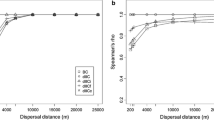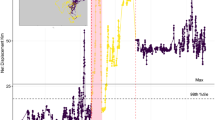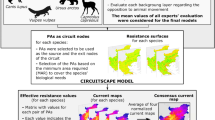Abstract
Context
In fragmented landscapes, connectivity between subpopulations is vital for species’ persistence. Various techniques are used to assess the degree of connectivity between habitat patches, yet their performance is seldom evaluated. Models are regularly based on habitat selection by individuals in resident populations, yet dispersers may not require habitat which supports permanent residence.
Objectives and methods
Using a database of African wild dog (Lycaon pictus) occurrence records in north-eastern South Africa (n = 576), we developed and compared ecological niche models (ENM) for wild dogs packs and dispersers. Additionally, we used least cost path (LCP) and current flow models to assess connectivity. Results were further validated using occurrence records (n = 339) for cheetah (Acinonyx jubatus).
Results and conclusions
The ENM for wild dog packs identified large but isolated patches of suitable habitat, while the disperser ENM had greater suitability values for areas in between highly suitable patches. Without disperser-specific data, models omitted large areas which were confirmed to have provided connectivity. Although models derived from a potentially subjective cost layer have been criticised, the current flow model outperformed the other connectivity techniques and provided the most meaningful predictions for conservation planning. We identified five priority conservation areas for wild dogs, two of which had a greater feasibility for recolonisation. The scarcity of disperser-specific data promotes models using habitat data for resident individuals but here we illustrate the pitfalls thereof. Our study provides insights into the performance of these frequently employed techniques and how they may affect conservation management decisions.







Similar content being viewed by others
References
Adriaensen F, Chardon JP, Blust GD, Swinnen E, Villalba S, Gulinck H, Matthysen E (2003) The application of ‘least-cost’ modelling as a functional landscape model. Landsca Urban Plan 64:233–247
Beier P, Majka DR, Spencer WD (2008) Forks in the road: choices in procedures for designing wildland linkages. Conserv Biol 22:836–851
Cardillo M, Mace GM, Jones KE, Bielby J, Bininda-Emonds ORP, Sechrest W, Orme CDL, Purvis A (2005) Multiple causes of high extinction risk in large mammal species. Science 309:1239–1241
Carroll C, Mcrae BH, Brookes A (2012) Use of linkage mapping and centrality analysis across habitat gradients to conserve connectivity of gray wolf populations in Western North America. Conserv Biol 26:78–87
Creel S, Creel NM (2002) The African Wild dog: behaviour, ecology and conservation. Princeton University Press, Princeton
Cushman SA (2006) Effects of habitat loss and fragmentation on amphibians: a review and prospectus. Biol Conserv 128:231–240
Cushman SA, Mckelvey KS, Schwartz MK (2009) Use of empirically derived source–destination models to map regional conservation corridors. Conserv Biol 23:368–376
Dalerum F, Somers MJ, Kunkel K, Cameron EZ (2008) The potential for large carnivores to act as biodiversity surrogates in southern Africa. Biodivers Conserv 17:2939–2949
Davies-Mostert HT, Kamler JF, Mills MGL, Jackson CR, Rasmussen GSA, Groom RJ, Macdonald DW (2012) Long-distance transboundary dispersal of African wild dogs among protected areas in southern Africa. Afr J Ecol 50:500–506
Davies-Mostert HT, Mills MGL, Macdonald DW (2009) A critical assessment of South Africa’s managed metapopulation recovery strategy for African wild dogs and its value as a template for large carnivore conservation elsewhere. In: Hayward M, Somers M (eds) Reintroduction of Top-Order Predators. Blackwell Publishing, Oxford
Dobson A, Lodge D, Alder J, Cumming GS, Keymer J et al (2006) Habitat loss, trophic collapse, and the decline of ecosystem services. Ecology 87:1915–1924
Elith J, Graham CH, Anderson RP, Dudik M, Ferrier S, Guisan A et al (2006) Novel methods improve prediction of species’ distributions from occurrence data. Ecography 29:129–151
Fagan WF, Calabrese JM (2006) Quantifying connectivity: balancing metric performance with data requirements. In: Crooks KR, Sanjayan M (eds) Connectivity Conservation. Cambridge University Press, New York, pp 297–317
Fahrig L (2003) Effects of habitat fragmentation on biodiversity. Annu Rev Ecol Evol Syst 34:487–515
Ferreras P (2001) Landscape structure and asymmetrical inter-patch connectivity in a metapopulation of the endangered Iberian lynx. Biol Conserv 100:125–136
Fuller TK, Kat PW, Bulger JB, Maddock AH, Ginsberg JR, Burrows R, McNutt JW, Mills MGL (1992) Population dynamics of African wilddogs. In: McCullough DR, Barrett H (eds) Wildlife 2001: populations. Elsevier Science Publishers, London, pp 1125–1139
Graves TA, Farley S, Goldstein MI, Servheen C (2007) Identification of functional corridors with movement characteristics of brown bears on the Kenai Peninsula, Alaska. Landscape Ecol 22:765–772
Hilty JA, Merenlender AM (2004) Use of riparian corridors and vineyards by mammalian predators in Northern California. Conserv Biol 18:126–135
Huck M, Jędrzejewski W, Borowik T, Miłosz-Cielma M, Schmidt K, Jędrzejewska B, Nowak S, Mysłajek RW (2011) Habitat suitability, corridors and dispersal barriers for large carnivores in Poland. Acta Theriol 56:91–101
Hutcheson K (1970) A test for comparing diversities based on the Shannon formula. J Theor Biol 29:151–154
Jackson CR, Robertson MP (2011) Predicting the potential distribution of an endangered cryptic subterranean mammal from few occurrence records. J Nat Conserv 19:87–94
Lee-Yaw JA, Davidson A, McRae BH, Green DM (2009) Do landscape processes predict phylogeographic patterns in the wood frog? Mol Ecol 18:1863–1874
Lindsey P, du Toit JT, Mills MG, Alexander R (2005a) The potential contribution of ecotourism to wild dog Lycaon pictus conservation. Biol Conserv 123:339–348
Lindsey P, du Toit JT, Mills MGL (2004) The distribution and population status of African wild dogs Lycaon pictus outside protected areas in South Africa. S Afr J Wildl Res 34:143–151
Lindsey PA, Du Toit JT, Mills MG (2005b) Attitudes of ranchers towards African wild dogs Lycaon pictus: conservation implications for wild dogs on private land. Biol Conserv 125:113–121
Lindsey PA, Romañach SS, Davies-Mostert HT (2009) The importance of conservancies for enhancing the value of game ranch land for large mammal conservation in southern Africa. J Zool 277:99–105
Margules CR, Pressey RL (2000) Systematic conservation planning. Nat (Lond) 405:243–253
Masenga EH, Jackson CR, Mjingo EE, Jacobson A, Riggio J, Lyamuya RD, Fyumagwa RD, Borner M, Røskaft E (in press) Insights into long-distance dispersal by African wild dogs in East Africa. Afr J Ecol. doi:10.1111/aje.12244
McNutt JW (1996) Sex-biased dispersal in African wild dogs, Lycaon pictus. Anim Behav 52:1067–1077
McRae BH, Dickson BG, Keitt TH, Shah VB (2008) Using circuit theory to model connectivity in ecology and conservation. Ecology 10:2712–2724
McRae BH, Kavanagh DM (2011). Linkage mapper connectivity analysis software. The Nature Conservancy, Seattle. Available from http://www.circuitscape.org/linkagemapper (Accessed Nov 2012)
Merrill T, Mattson DJ, Wright RG, Quigley HB (1999) Defining landscapes suitable for restoration of grizzly bears Ursus arctos in Idaho. Biol Conserv 87:231–248
Mucina L, Rutherford MC (2006) The vegetation of South Africa, Lesotho and Swaziland., Strelitzia 19South African National Biodiversity Institute, Pretoria
Newman MEJ (2005) A measure of betweenness centrality based on random walks. Soc Netw 27:39–54
Noss RF, Quigley HB, Hornocker MG, Merrill T, Paquet PC (1996) Conservation biology and carnivore conservation in the Rocky Mountains. Conserv Biol 10:949–963
Palomares F, Delibes M, Ferreras P, Fedriani JM, Calzada J, Revilla E (2000) Iberian Lynx in a fragmented landscape: predispersal, dispersal, and postdispersal habitats. Conserv Biol 14:809–818
Phillips SJ, Anderson RP, SchapireR E (2006) Maximum entropy modeling of species geographic distributions. Ecol Model 190:231–259
Ray N, Burgman MA (2006) Subjective uncertainties in habitat suitability maps. Ecol Model 195:172–186
Richard Y, Armstrong DP (2010) Cost distance modelling of landscape connectivity and gap-crossing ability using radio-tracking data. J Appl Ecol 47:603–610
Sawyer SC, Epps CW, Brashares JS (2011) Placing linkages among fragmented habitats: do least-cost models reflect how animals use landscapes? J Appl Ecol 48:668–678
Swanson A, Caro T, Davies-Mostert H, Mills MGL, Macdonald DW, Borner M, Masenga E, Packer C (2014) Cheetahs and wild dogs show contrasting patterns of suppression by lions. J Anim Ecol 83:1418–1427
Thorn M, Green M, Scott D, Marnewick K (2013) Characteristics and determinants of human-carnivore conflict in South African farmland. Biodivers Conserv 22:1715–1730
van Dyk G, Slotow R (2003) The effects of fences and lions on the ecology of African wild dogs reintroduced to Pilanesberg National Park, South Africa. Afr Zool 38:79–94
WAG-SA (2014) Minutes of the Wild dog advisory group of South Africa (WAG-SA) meetings. Johannesburg, South Africa
Wilcove DS, Rothstein D, Dubow J, Phillips A, Losos E (1998) Quantifying threats to imperiled species in the United States. Bioscience 48:607–615
Woodroffe R, Ginsberg JR (1998) Edge effects and the extinction of populations inside protected areas. Science 280:2126–2128
Woodroffe R, Ginsberg JR (1999) Conserving the African wild dog Lycaon pictus. I. Diagnosing and treating the causes of decline. Oryx 33:132–142
Acknowledgments
We are grateful to the Endangered Wildlife Trust for making wild dog and cheetah occurrence records available to us, as well as to all the volunteers who submitted the sighting records of these species. Rosie Woodroffe, Jon Swenson, and two anonymous reviewers are thanked for constructive suggestions.
Author information
Authors and Affiliations
Corresponding author
Electronic supplementary material
Below is the link to the electronic supplementary material.
Rights and permissions
About this article
Cite this article
Jackson, C.R., Marnewick, K., Lindsey, P.A. et al. Evaluating habitat connectivity methodologies: a case study with endangered African wild dogs in South Africa. Landscape Ecol 31, 1433–1447 (2016). https://doi.org/10.1007/s10980-016-0342-5
Received:
Accepted:
Published:
Issue Date:
DOI: https://doi.org/10.1007/s10980-016-0342-5




